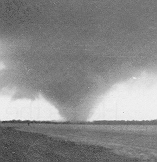|
|
|
|
TORNADO SAFETY INFORMATION
 Tornadoes have occurred during every month of the year. However, statistics show
April, May, and June are the peak months for tornado activity. These
months also give thunderstorm activity. The National Weather Service will
provide various watches and warnings to keep the citizens informed of
conditions. A tornado is a violently rotating column of air in contact
with the ground. If you see a debris cloud under a thunderstorm, you have a
tornado. You may see funnels dropping from a cloud, but it does not become a
tornado until it touches the ground.
Tornadoes have occurred during every month of the year. However, statistics show
April, May, and June are the peak months for tornado activity. These
months also give thunderstorm activity. The National Weather Service will
provide various watches and warnings to keep the citizens informed of
conditions. A tornado is a violently rotating column of air in contact
with the ground. If you see a debris cloud under a thunderstorm, you have a
tornado. You may see funnels dropping from a cloud, but it does not become a
tornado until it touches the ground.
Explaination of terms used by The National Weather ServiceSevere Thunderstorm Watch: Issued by the Storm
Prediction Center. : A severe thunderstorm has been detected by radar or by a trained weather spotter. Severe thunderstorms produce hail that is 3/4 inch or larger in diameter and/or winds in excess of 58 miles per hour. Tornadoes can be spawned from severe thunderstorms. You need to take cover immediately from these storms. They are very dangerous. Tornado Watch: Issued by the Storm
Prediction Center. : A tornado has been indicated by radar or sited by trained storm spotters. The warning will include where the tornado is seen or indicated and what communities are in its path. When a tornado warning has been issued for your area, take cover immediately.
The safest places to go for shelterAt Home: In your basement under something sturdy (such as a workbench) or under the stairs. If you don't have a basement, the best place is a small, windowless room near the center of your apartment or house. A closet or bathroom is ideal. Stay away from windows.At School or Work: Go to a designated shelter. If there is no time, crouch under your desk or seek shelter in a closet or bathroom. Stay away from exterior walls and windows. Also stay away from large open rooms (auditorium or gym). In Shopping Malls: Go to the designated areas or to the center of the building on a low level. Stay away from large, open rooms and windows. NEVER seek shelter in cars in the parking lot. Outside, In Mobile Homes or Cars: Go into the nearest building, store, or garage. DO NOT SEEK SHELTER IN YOUR VEHICLE. If you are driving and find a tornado is moving toward you, leave your vehicle and lie down in a low area (a ditch). Cover the back of your head and neck with your hands to protect yourself from severe head injury.
After the storm passes
|
|
Send mail to shamiller@WCTel.net with
questions or comments about this web site.
|